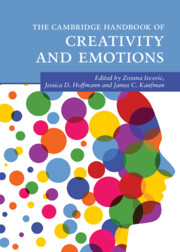Book contents
- The Cambridge Handbook of Creativity and Emotions
- Cambridge Handbooks in Psychology
- The Cambridge Handbook of Creativity and Emotions
- Copyright page
- Dedications
- Contents
- Figures
- Tables
- Contributors
- Acknowledgments
- Creativity and Emotions
- Part I Methods in the Study of Creativity and Emotions
- Part II The Development of Creativity
- Part III Emotions and the Creative Person
- Part IV Emotions and Creative Products
- Part V Emotions and Creativity at School and Work
- 24 Anxiety, Fear of Failure, and Creativity
- 25 Peers, Affect, and Creativity at School
- 26 Creative Curricular Experiences
- 27 Organizational Affective Climate and Creativity at Work
- 28 Group Affect and Creativity
- 29 Psychological Safety and Creativity
- 30 Leadership, Creativity, and Emotions
- 31 A Multilevel Model of Emotions and Creativity in Organizations
- 32 Creativity and Emotion
- Index
- References
28 - Group Affect and Creativity
from Part V - Emotions and Creativity at School and Work
Published online by Cambridge University Press: 16 February 2023
- The Cambridge Handbook of Creativity and Emotions
- Cambridge Handbooks in Psychology
- The Cambridge Handbook of Creativity and Emotions
- Copyright page
- Dedications
- Contents
- Figures
- Tables
- Contributors
- Acknowledgments
- Creativity and Emotions
- Part I Methods in the Study of Creativity and Emotions
- Part II The Development of Creativity
- Part III Emotions and the Creative Person
- Part IV Emotions and Creative Products
- Part V Emotions and Creativity at School and Work
- 24 Anxiety, Fear of Failure, and Creativity
- 25 Peers, Affect, and Creativity at School
- 26 Creative Curricular Experiences
- 27 Organizational Affective Climate and Creativity at Work
- 28 Group Affect and Creativity
- 29 Psychological Safety and Creativity
- 30 Leadership, Creativity, and Emotions
- 31 A Multilevel Model of Emotions and Creativity in Organizations
- 32 Creativity and Emotion
- Index
- References
Summary
The role of affect in individual creativity is well established in extensive theory and empirical research. Scholars have proven that positive and negative feelings can promote creativity due to psychological processes associated with information processing and motivation. However, the function of group-level affect, namely, the shared feelings experienced among members of the same groups, for the same outcomes, have received limited attention in research and practice. This chapter addresses this dearth of knowledge by examining and summarizing the studies available in this field of inquiry and proposing a theoretical elaboration to better understand why group-level affect matters for creativity in groups. Based on this work, we propose that the influences of group affect on creativity outcomes occur through social integration mechanisms such as cohesion, trust, and collaboration. Finally, we identify and suggest future opportunities for research.
- Type
- Chapter
- Information
- The Cambridge Handbook of Creativity and Emotions , pp. 540 - 558Publisher: Cambridge University PressPrint publication year: 2023



